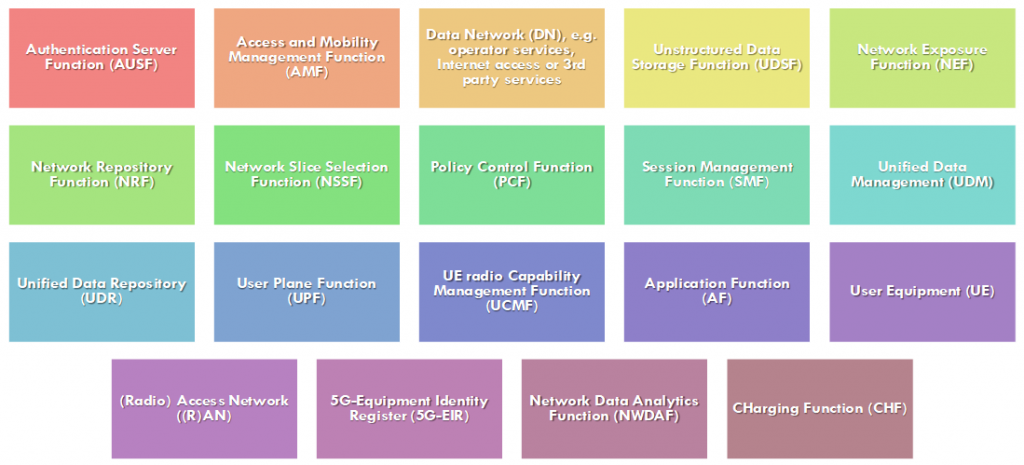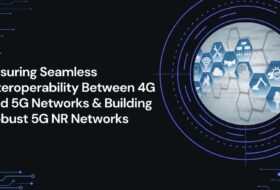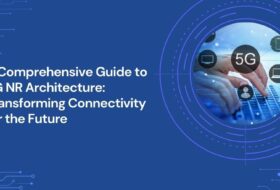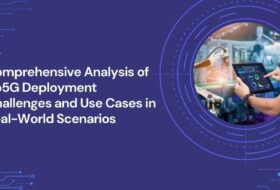The 5G System architecture consists of the following network functions (NF).

Service-based interfaces: This Service based interface is connected to each interface.
The 5G System Architecture contains the following service-based interfaces:
| SBI Interface | |
| Namf | Service-based interface exhibited by AMF |
| Nsmf | Service-based interface exhibited by SMF |
| Nnef | Service-based interface exhibited by NEF |
| Npcf | Service-based interface exhibited by PCF |
| Nudm | Service-based interface exhibited by UDM |
| Naf | Service-based interface exhibited by AF |
| Nnrf | Service-based interface exhibited by NRF |
| Nnssf | Service-based interface exhibited by NSSF |
| Nausf | Service-based interface exhibited by AUSF |
| Nudr | Service-based interface exhibited by UDR |
| Nudsf | Service-based interface exhibited by UDSF |
| N5g-eir | Service-based interface exhibited by 5G-EIR |
| Nnwdaf | Service-based interface exhibited by NWDAF |
| Ni-nef | Service-based interface exhibited by I-NEF |
| Nchf | Service-based interface exhibited by CHF |
| Nucmf | Service-based interface exhibited by UCMF |
Reference points
The 5G System Architecture contains the following reference points:
The 5G system reference Point interface us a set if Point to point interfaces which inter connect those Network Elements.
- N1: Reference point between the UE and the AMF.
- N2: Reference point between the (R)AN and the AMF.
- N3: Reference point between the (R)AN and the UPF.
- N4: Reference point between the SMF and the UPF.
- N6: Reference point between the UPF and a Data Network.
- NOTE 1: The traffic forwarding details of N6 between a UPF acting as an uplink classifier and a local data network are not specified in this Release of the specification.
- N9: Reference point between two UPFs.
- The following reference points show the interactions that exist between the NF services in the NFs. These reference points are realized by corresponding NF service-based interfaces and by specifying the identified consumer and producer NF service as well as their interaction in order to realize a particular system procedure.
- N5: Reference point between the PCF and an AF.
- N7: Reference point between the SMF and the PCF.
- N8: Reference point between the UDM and the AMF.
- N10: Reference point between the UDM and the SMF.
- N11: Reference point between the AMF and the SMF.
- N12: Reference point between AMF and AUSF.
- N13: Reference point between the UDM and Authentication Server function the AUSF.
- N14: Reference point between two AMFs.
- N15: Reference point between the PCF and the AMF in the case of non-roaming scenario, PCF in the visited network and AMF in the case of roaming scenario.
- N16: Reference point between two SMFs, (in roaming case between SMF in the visited network and the SMF in the home network).
- N16a: Reference point between SMF and I-SMF.
- N17: Reference point between AMF and 5G-EIR.
- N18: Reference point between any NF and UDSF.
- N19: Reference point between two PSA UPFs for 5G LAN-type service.
- N22: Reference point between AMF and NSSF.
- N23: Reference point between PCF and NWDAF.
- N24: Reference point between the PCF in the visited network and the PCF in the home network.
- N27: Reference point between NRF in the visited network and the NRF in the home network.
- N28: Reference point between PCF and CHF.
- N29: Reference point between NEF and SMF.
- N29i: Reference point between I-NEF and SMF in the VPLMN.
- N30: Reference point between PCF and NEF.
- NOTE 2: The functionality of N28 and N29 and N30 reference points are defined in TS 23.503 [45].
- N31: Reference point between the NSSF in the visited network and the NSSF in the home network.
- NOTE 3: in some cases, a couple of NFs may need to be associated with each other to serve a UE.
- In addition to the reference points above, there are interfaces/reference point(s) between SMF and the CHF. The reference point(s) are not depicted in the architecture illustrations in this specification.
- NOTE 4: The functionality of these interface/reference points are defined in TS 32.240 [41].
- N32: Reference point between SEPP in the visited network and the SEPP in the home network.
- NOTE 5: The functionality of N32 reference point is defined in TS 33.501 [29].
- N33: Reference point between NEF and AF.
- N34: Reference point between NSSF and NWDAF.
- N35: Reference point between UDM and UDR.
- N36: Reference point between PCF and UDR.
- N37: Reference point between NEF and UDR.
- N38: Reference point between I-SMFs.
- N40: Reference point between SMF and the CHF.
- NOTE 6: The reference points from N40 up to and including N49 are reserved for allocation and definition in TS 23.503 [45].
- N50: Reference point between AMF and the CBCF.
- N51: Reference point between AMF and NEF.
- N51i: Reference point between I-NEF and the AMF in the VPLMN.
- N52: Reference point between NEF and UDM.
- N53: Reference point between the I-NEF and the NEF.
- N55: Reference point between AMF and the UCMF.
- N56: Reference point between NEF and the UCMF.
- N57: Reference point between AF and the UCMF.
- N58: Reference point between AF and the NEF








Comments
Comments are closed.